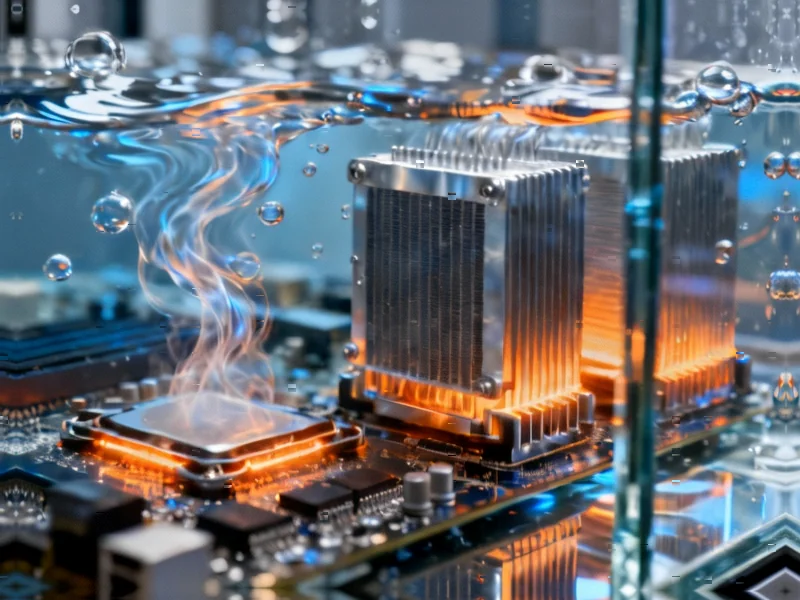The Cooling Conundrum Intensifies
Data centers are facing a thermal crisis that’s only getting worse. The explosive growth of artificial intelligence and cloud computing is creating unprecedented cooling demands, with traditional methods struggling to keep pace. According to industry analysis, the data center industry is projected to grow at a remarkable 11.8% compound annual rate through 2030, putting even more pressure on thermal management systems.
Table of Contents
“Processing an ever-growing amount of data requires more power, but more power generates more heat – the enemy of reliable electronics,” notes Jason Wei, a senior scientist at Dow with 17 years of experience in thermal materials development. His observation highlights the fundamental challenge: as servers become more powerful, they generate heat that conventional cooling can’t efficiently manage.
Traditional Methods Hit Their Limits
Air-based cooling approaches, while cost-effective for less demanding applications, simply can’t handle the concentrated heat output of today’s high-performance computing clusters. Meanwhile, water-based systems present their own set of problems. Reports indicate that water consumption has become a major environmental concern, with medium-sized data centers potentially using up to 110 million gallons annually according to Environmental and Energy Study Institute data.
Water’s thermal conductivity makes it attractive for cooling, but maintaining proper levels and preventing leaks requires constant monitoring. The environmental footprint of such massive water usage is driving the industry toward more sustainable alternatives.
Immersion Cooling Gains Momentum
Thermal immersion cooling is emerging as a compelling solution to these challenges. Unlike other methods that rely on air or targeted liquid cooling, this approach completely submerges servers in thermally conductive dielectric fluids. The results, according to market research from Mordor Intelligence, are dramatic: 91% reduction in water consumption, 39% lower carbon emissions, and total cost of ownership savings reaching 30%.
Perhaps most impressively, the power usage effectiveness (PUE) metric – a crucial measure of data center efficiency – drops to just slightly above 1.0 with immersion cooling. That compares favorably to traditional air conditioning systems at 1.8 or even direct-to-chip cooling at 1.2, according to BIS Research analysis.
The Coolant Evolution
Not all immersion coolants are created equal, however. The industry has experimented with various options, each with significant drawbacks. Fluorocarbons, while effective, face environmental scrutiny due to their global warming potential and inclusion of persistent “forever chemicals” known as PFAS. Synthetic oils cost less but present fire safety risks and can damage electronic components.
Pure silicone fluids offered better thermal management and fire safety, but created compatibility issues with silicone-based materials commonly used in server electronics. “Silicone fluids can cause these other silicone materials to swell, and changes to shape and size generate mechanical stress,” Wei explains, highlighting the delicate balance required in coolant chemistry.
Hybrid Chemistry Breakthrough
The latest development in this space involves hybrid coolants combining silicone and hydrocarbon chemistry. These novel materials appear to address previous limitations while maintaining performance advantages. Industry sources suggest the hybrid approach delivers non-flammable properties while maintaining broad compatibility with electronic materials, reducing leakage risks and simplifying maintenance.
Compared to pure hydrocarbons, the hybrid coolants reportedly offer superior thermal stability – crucial for handling the intense heat generated by AI workloads. Their improved chemical stability means they’re less likely to break down over time, supporting longer service life and more reliable performance.
Additional benefits include corrosion protection for system hardware and high shear resistance that prevents breakdown from mechanical pumping stress. For data center operators, these advances could translate into reduced downtime and lower maintenance costs.
Sustainable Future for Data Centers
As the data center industry continues its rapid expansion, cooling technology is becoming a critical differentiator for both operational efficiency and environmental sustainability. The combination of immersion cooling with advanced hybrid coolants represents a significant step forward in addressing the thermal management challenges posed by next-generation computing demands.
With water conservation becoming increasingly important in many regions and energy costs remaining volatile, solutions that deliver both environmental and economic benefits are particularly valuable. The progress in thermal immersion cooling suggests that the industry may have found a path to supporting AI’s growth without proportionally increasing its environmental footprint.



